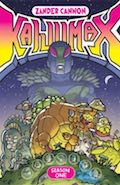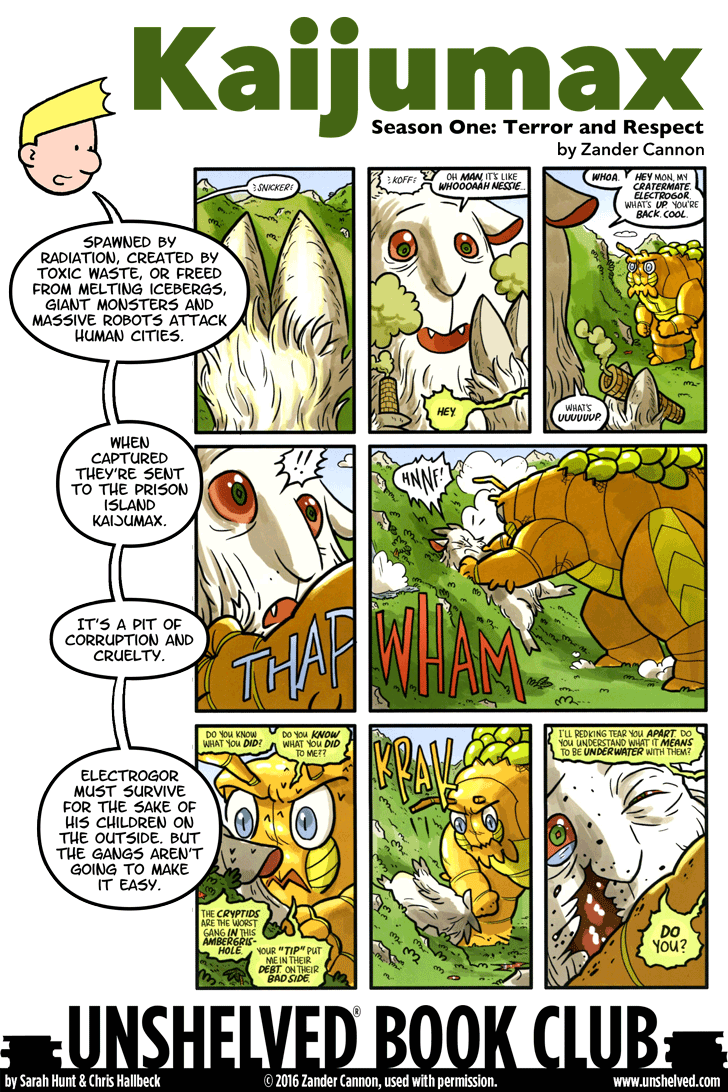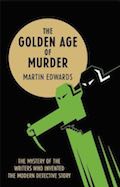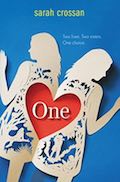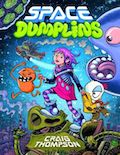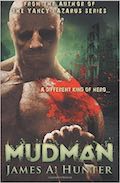Link to this review in the form of a comic strip by sarahhunt tagged science fiction • graphic novel
Link to this review by robert tagged nonfiction • mystery
Mystery writer Martin Edwards has a thesis: British dominance of mystery writing during the period between world wars, in terms of output and quality, was nurtured by the Detection Club, a dining club that also served as a writer’s group.
The book covers the careers of individual writers, such as the prolific and long-lived Agatha Christie, the highly regarded Dorothy L. Sayers, and British Poet Laureate Cecil Day-Lewis (who wrote mysteries as Nicholas Blake). It also explores the critical understanding of mysteries. Book blurb texts of the time concentrated on the puzzles to be solved, but Edwards contends many of the books of the day also included substantial themes of social significance. His most provocative point: the question of when murder may be the right thing to do came to the fore when Adolf Hitler came to power. Edwards also covers many members’ interest in and writings about true crime. He describes the club’s efforts at collaborative fiction (including radio dramas) and its rituals. Members vowed, “To do and detect all crimes by fair and reasonable means; to conceal no vital clues from the reader; to honour the King’s English…”
Why I picked it up: It wasn’t just the lurid cover. I’m a mystery reader, and any book with a subtitle like this was going to attract my attention.
Why I finished it: Edwards, who is not only President of the Detection Club but also its archivist, knows his stuff. This ranges from the difficulties in getting writers to collaborate on The Floating Admiral to authors’ personal tragedies and scandals, like Agatha Christie’s disappearance and Dorothy L. Sayers’ illegitimate child. Edwards even lets slip that “Yorick,” the human skull still used in the club’s initiation rites, may have been that of a woman.
Readalikes: This suggestive, argumentative book sent me to libraries and used book stores in search of the works it mentions, so it’s full of its own reading recommendations. Here are a few others. Julian Symons’ Bloody Murder: From the Detective Story to the Crime Novel has, for decades, been the go-to critical history of the mystery, and Martin Edwards acknowledges his considerable debt to Symons and his work. The Department of Dead Ends by Roy Vickers collects ten inverted detective stories in which readers see the crimes committed — the trick is to figure out how the detectives will solve them. (This is a form of detective story that became well-established in the Golden Age.) Finally, former Detection Club President Dorothy L. Sayers’ Have His Carcase benefitted from workshopping with the group. According to Edwards, Sayers consulted with member John Rhode about cryptography (Sayers’ sleuth demonstrates a nice probable word attack against a difficult (in that age) Playfair cipher) and with medical professionals in and outside the club about forensics.
Link to this review by murphy'smom tagged coming of age
Tippi and Grace are sixteen-year-old conjoined twins. The girls look alike but have totally different personalities and aspirations. When they fight they cannot get away from the other.
The summer before their junior year, their parents tell the girls the state will pay for them to attend an elite private school. They have been homeschooled to this point to keep them sheltered from other kids’ cruelty, so the idea of going to a “regular” school is exciting and terrifying. At school the girls manage to make friends. Because of the extra stress, though, Tippi falls down a lot (and takes Grace with her). After a series of tests, doctors discover Tippi’s heart is getting weaker. The family has to make a choice: if the twins stay conjoined, both could die but if the two girls are separated, their chances of survival are only slightly higher.
Why I picked it up: The cover, with two paper doll cutouts made from a single sheet of paper, caught my attention, particularly after I started noticing the subtle differences on the girls’ dresses.
Why I finished it: It was written in free verse, and I enjoyed the way it moved between Tippi’s and Grace’s voices. I first felt sorry for the girls but later I realized they didn’t want sympathy, they just wanted compassion and understanding like the rest of us.
It’s perfect for: I would love for my nephew and niece, Shelton and Reese, Irish twins whose birthdays are only eleven months apart, to read it. The two of them have never known life without the other. How many other newborns have been at their older brother’s first birthday party?
Readalikes: Because it’s also in free verse, Ellen Hopkins’ first YA novel, Crank, reminded me of One. Kristina is an innocent sixteen-year-old who goes to live with her father for the summer, and he gets her hooked on crystal meth. When Kristina is high, her alter-ego, Bree, comes out and she is the total opposite of shy, awkward Kristina. Despite its heart-wrenching topic, its poetic language helped me stay engaged throughout. One also reminded me of Wonder by R.J. Palacio, about a disfigured boy, Auggie, who was born with severe facial abnormalities and has also been homeschooled. When his parents decide he should start regular school, he expects the worst but wants friends and acceptance.
Link to this review by geneambaum tagged picture book
An alien lands on a rooftop high in the city. He’s greeted by the mayor and an astronomer and makes his way ever lower into the city for a parade and an epic game of hide-and-seek. After an incident involving a massive tea party, the alien falls in love with a mermaid and they visit one of her friends deep beneath the city.
Why I picked it up: The front cover promises “a vertical story 10 feet tall” and the back includes a bunch of things to spot throughout, including eight ghosts, twenty birds, and ninety-four cakes. What?
Why I finished it: The design is brilliant. As the pages are flipped, new text appears under the current image. Folding out the pages creates one continuous image that tells the entire story. (The text is all on the back by the time you’ve opened and unfolded the entire book.) There are a huge number of details to get lost in after you’ve tracked the alien through the first time.
Readalikes: This immediately reminded me of Welcome to Mamoko and its sequels, which also have a ton of fun details to follow. There are a lot of different characters (including an alien), each of whom has a story revealed over seven huge, wordless, two-page images. And it’s super fun, just like Megalopolis.
Link to this review by dawnrutherford tagged graphic novel • science fiction
Violet lives in a beat-up old spaceship in a rough “trailer park.” Her father hauls junk, and her mother works in a garment factory. They struggle just to get by. Violet’s world is shaken up when a space whale demolishes her school and her father goes missing. Her mother has a new job at a fancy design studio and is always working to keep them afloat. Convinced no one else is trying, Violet leads her friends on a dangerous mission to find her father.
Why I picked it up: Craig Thompson is one of my favorite graphic novelists. His work usually involves fantastically detailed art and an unsettling subject that challenges the status quo.
Why I finished it: This a great science fiction tale for kids that’s packed with bizarre aliens and delightfully complex environments from junkyards to factories to deep space, all filled with minute details. The level of detail Thompson puts into the illustrations is worth pouring over for a second or third time, and the amazing spaceships will inspire kids to start drawing their own. One of my favorite images is the anatomical cutaway of a giant space whale that shows its brain, spine, heart, and digestive system, which contains a spaceship in its depths.
Readalikes: This would be an excellent next step for any tween who read and enjoyed Zita the Space Girl. Both have a wonderful assortment of characters, humanoid and other, and a strong message about the value of friendship.
Link to this review by flemtastic tagged fantasy
Levi is a seventy-year-old Jewish golem created to right injustices during the Holocaust. Having survived long past his original purpose, he tries to live simply, and is currently living as a middle-aged Mennonite to help calm his violent urges to wipe out evil beings. But when his bloodlust overcomes him, Levi goes to the Hub, a world where magical creatures congregate. There, while Levi is methodically hunting down a troop of kobocks (if you’re a D&D geek, think kobolds), he stops a ceremony and frees Ryder, a human woman who was about to be sacrificed. Protecting her and stopping the forces bent on freeing a mad god requires that Levi once again become an evil killing machine.
Why I picked it up: I wanted to read a book where a golem was the main character to learn more about their mythology.
Why I finished it: Levi’s golem powers were unlike any I had seen in fantasy before, and he was very creative in using them. Right from the start, Levi changes his body structure, melding himself into a tunnel wall to ambush two kobocks as they meander past. He appears from nowhere and takes them out like Stallone in this moment from Rambo: First Blood Part II. Other times he molds his hands into cleaving instruments like axes or long blades, and creates a void in his body to store items. And his special golem blood enables him to take different forms.
It’s perfect for: My friend and colleague, author Allan Batchelder, because a homunculus features prominently in his next Immortal Treachery book.
